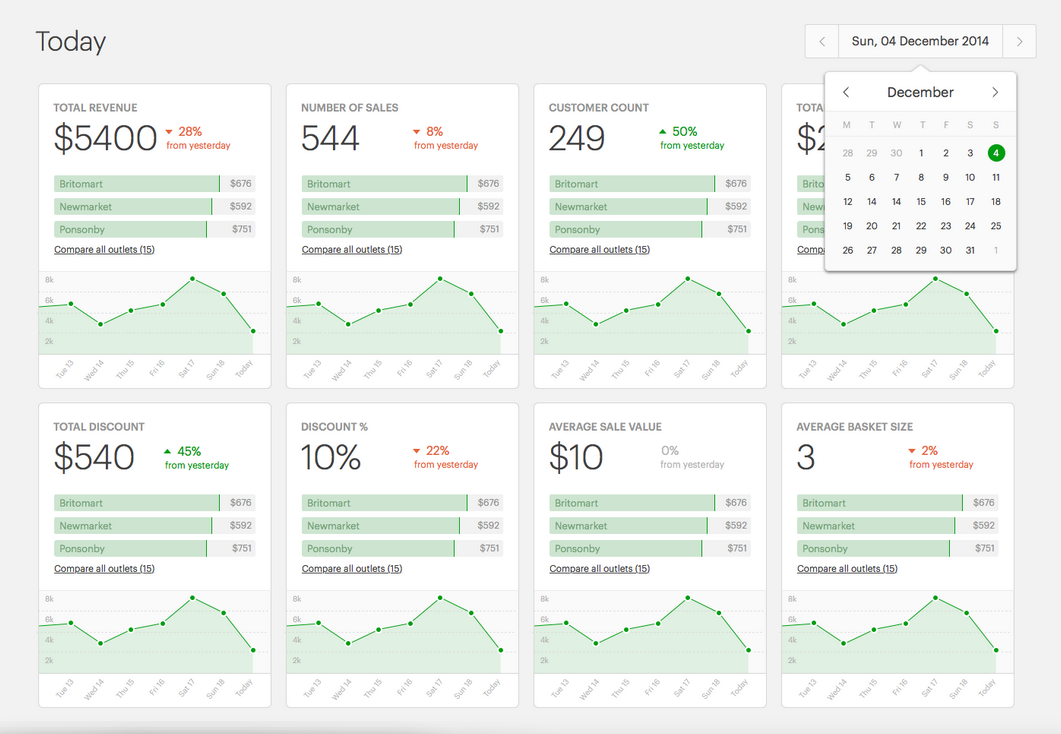There’s some truth to the saying “You have to spend money to make money.” When you’re running a business, shelling out without seeing an immediate return is part of the territory. The question is, which products or services are worth spending money on?
This blog post sheds light on a few areas of your business you may want to consider investing in, along with tips on minimizing risk and spending your money wisely. Hopefully, it’ll give you some ideas on how to allocate your resources next year. Check them out:
1. Invest in data and analytics
Retail is going to be a lot more competitive in 2015. The best way to compete is to arm yourself with tools that help you better understand your business and customers—and, in turn, make smarter, more profitable decisions.
Consider the story of T-We Tea, a San Francisco-based retailer that sells blended teas and tea accessories. They used Vend to analyze their inventory and identify their top-sellers.
The reports told T-We Tea that, while sales were increasing, their customers were purchasing more of their low-margin items (like accessories), instead of their house-made teas.
To address this, T-We Tea bundled up their top-sellers with their high-margin merchandise and sold those bundles at a discounted rate. This move, along with other tweaks, enabled the business to increase revenues by 300%.
You can achieve similar results by investing in the right reporting tools. Make sure that your point-of-sale and inventory system gives you the necessary intel to know exactly what’s selling and who’s buying from you.
Vend, for example, can generate reports that will show you sales totals for a specific time period, customer group, or supplier. These insights can help you make better merchandising and marketing decisions.
Also consider investing in foot-traffic tools, such as beacons, to get data on the in-store behavior of your customers. One company that enables this is Swarm, whose deeper analytics will reveal how much traffic you’re getting, what your peak hours are, and which parts of your store are getting the most and least traffic. Swarm can even connect to your POS system so you can link foot traffic data with sales and determine your conversion rates.
All that information could then help you make decisions on staffing, store layout, sales and more.
2. Ramp up your presence in other channels
Omnichannel isn’t just a buzzword. It really is the future of retail. Modern shoppers want the ability to research, browse, and shop across multiple channels and, in 2015, this trend is only going to get bigger.
As IDC’s Miya Knights noted in our post about Retail Trends and Predictions for 2015:
Consumers don’t distinguish between channels. They are channel blind; therefore, they expect the same service, products, offers, and pricing online as they do in-store and on mobile. This is why merchants need to make sure that their retail propositions are consistent across all channels.
Does your business have a presence in every retail channel? If not, find ways to change that. For instance, if you’re a brick-and-mortar store with no online presence, then invest in a website or e-commerce store so you can start selling online.
This also works both ways. If you have an e-commerce site but don’t have a presence in the physical realm, think of ways to reach people offline. Why not set up a pop-up store or hold offline events every once in a while?
If you already have brick-and-mortar and e-commerce covered, look into mobile. Create a smartphone-friendly website or introduce mobile ordering to give customers another buying mode.
That’s what Burger Wisconsin did when it launched mobile ordering with the help of Mobi2Go. Nick Rodgers, field service rep for the restaurant, told the Mobi2Go team, “We realised we were putting road-blocks in front of customers that gave them an opportunity not to order from us. We had always thought people would be prepared to queue up and wait for a great product. This is not true of the modern consumer, which led to a change in thinking.”
3. Invest in mobile devices
A lot of entrepreneurs find it worthwhile to invest in mobile devices such as tablets, which allow you to be productive practically anywhere. Take lifestyle coach Dianne Daniel, who says that the best investment she ever made in her business was her iPad.
“It’s become my go-to-accessory and I carry it everywhere. I can use it to transfer files, access and update my own websites, work on promotional materials, research information for articles and new products, and also keep up with information on forums I belong to that speak to my target market.
Other businesses are investing in iPads to streamline the checkout process and conduct business on the go. The Cheese and Wine Company, for instance, runs its point-of-sale and accounting systems on their iPad when in the shop, and on an iPad mini when they do outside events, allowing them to quickly and portably ring up sales.
4. Work on product improvement and innovation
Product improvement and innovation can mean different things. For some retailers, it could mean introducing new products or features. For others, it could be using superior ingredients or materials. The key is figuring out how to make your products better, and investing in the means to do it.
Consider what Stephanie Adams-Nicolai did. Stephanie owns a skincare business and says the best investment she made was to spend extra on top-notch ingredients. She chose to use only the finest-quality oils and herbs in her products, and this move “paid off royally,” resulting in rave reviews and “a great reputation for excellence.”
How can you figure out what improvements to invest in? Look at your sales and product data. Read reviews about your business. And, most important, talk to your customers. Are there any products or features missing from the ones you currently offer? What can you do to enhance your merchandise or store? Take all that feedback into consideration and find ways to make changes.
Minimizing investment risks
No investment comes without some risk, but you can minimize the downsides. Here’s how:
Plan it – Don’t buy into a product or idea just for the sake of it. Run the numbers and see that the investment makes sense. How much will it cost? How will you get the funds to make it happen? What’s your estimated ROI and how long will it be before you see results? These are just some of the questions you should answer before making the investment.
Take advantage of free trials – If you’re investing in a new product or service, ask if you can trial it for free. This will enable you to see if a solution is right for your business without having to shell out cash up front.
Don’t get tied down – Pick a solution that doesn’t come with a long-term contract. For example, if you’re investing in a new POS system, go with a solution that lets you cancel at any time instead of a company that ties you to a contract for many years.
Or, if you’re investing in new products or supplies, opt for a supplier who doesn’t require large minimum orders. That way, you can test items or supplies without investing too much capital in inventory.



